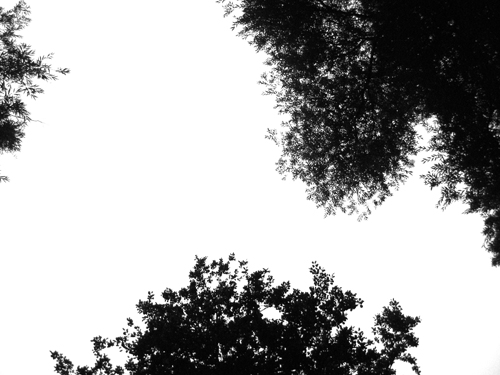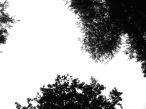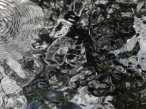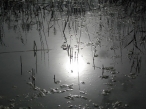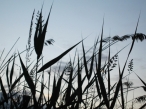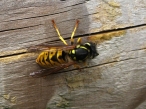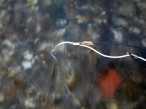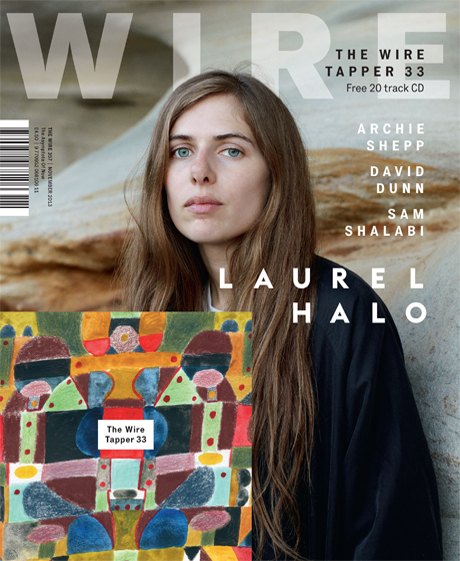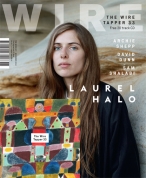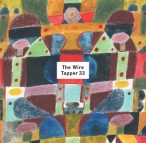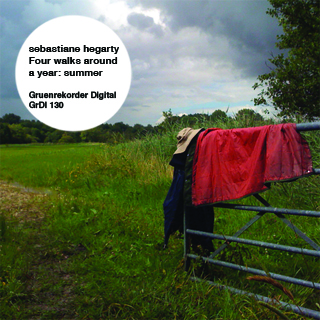
Four walks around a year: summer | Sebastiane Hegarty
winnall moors soundwalk
GrDl 130 | Gruen Digital > [order]
MP3 & FLAC
The summer sound walk begins with the dawn of the northern solstice, a day when the tilt of the earth is most inclined toward the sun. From here the listener walks over the reed beds and out into the working landscape of the northern moors, an area normally prohibited to even the most robustly booted public foot. Through this acoustic trespass, we gain admittance to the farms and working landscape of the moors. Here, Hampshire Wildlife Volunteers meet beneath the corrugated shelter of a barn roof, whilst outside the rain pours down from blocked gutters. The sound, or if you prefer, noise of work is an inherent part of the soundscape: the moors are not only a conservation area but also an ancient farmed environment. The intermittent percussion of hammers driving clips into wooden posts, sounds both distant and close, opening up a field of spatiality, which remains in a state perpetual flux. It is perhaps fittingly ironic, that the sound of people fencing space in, should conjure up notions of place as emergent and unfixed:
Acoustic space has no favoured focus. It’s a sphere without fixed boundaries, a space made by the thing itself, not space containing the thing. It’s not pictorial space, boxed-in, but dynamic, always in flux, creating its own dimensions moment by moment.
(Edmund Carpenter, Eskimo)
In the sonic landscape, things that are there are always close to not being there. Auditory space is temporal; the presence of any sound haunted by its absence. Walking through this field of summer, calendars of sounds, appear, disappear and return: the ‘centripetal’ bells of evensong, the abrasive electrical static of grasshoppers which, like acoustic pins in an empty map, establish momentary points or clusters of location. These insect songs will fade away with autumn, but reappear next spring, whilst others sounds are lost to any coming summer. A tree branch that has split and fallen over a wooden fence, introduces a transient Aeolian whine, a noise, which was there in this previous summer, but has now, with the removal of the branch, disappeared completely from the present field of sound. The use of contact microphones not only uncovers the sounds beneath the threshold of audition, allowing us to hear the gnawing of wasp mandibles on a wooden fence and the internal stress of tree trunks, they also bring into presence the ghost of sounds now no longer here. Today summer arrives again, and I am reminded that the intention of the Winnall Moors sound walks was not only to record and thereby discover the particular acoustic ecology of this local environment, but also to diffuse the borders of place and time. The listener may walk through their present summer whilst simultaneously listening to a summer now past. Sauntering through such a sonic palimpsest, the perimeters of time may become as permeable as those of place.
sound descriptors: a list of sounds as they appear on the summer walk
Dawn chorus, summer solstice, slow footfall on gravel path, a grasshopper warbler, a barn door opening, a barn door closing, overflowing gutter, a choir of hammers, two buzzards circling, cutting reeds, rain falling on barbed wire, wet leaves, rainfall on the surface of the river Itchen, the mini-stream, a coot on the pond, pondweed photosynthesis, a water boatman, a forest of creaking trees, a cluster of grasshoppers, a bee’s proboscis, wasps chewing on a wooden fence, petrol engine mower, path strimming, ice cream van, children’s voices, cows chewing, Wednesday evening bell practice at Winchester Cathedral, river hatch, a wire in the mini-stream, an evening cloud of Pipistrelles.
Background
The Winnall Moors soundwalk project was made in collaboration with Hampshire Wildlife Trust (HWT). The project began in the winter of 2010, with the aim of creating a soundwalk based on recordings made in the Winnall Moors conservation reserve over the period of one year. Extending the recording process over this timescale, allowed the discrete temporal patterns of the landscape to become apparent. The inclusive nature of the sounds collected, reflect both the complicated topography of the reserve, which is at once a shared public space, a historic and natural landscape and an area of encircled wilderness.
As the project progressed, it became apparent that composing one soundwalk for the whole year would be restrictive. It seemed more appropriate for there to be four walks, responding to individual acoustic character of the years celestial quarters: winter, spring, summer, autumn. The temporality of the sonic environment is reflected not only in the migratory, seasonal wildlife sounds, but also in the calendars of local, human and conservation activity.
The duration of each soundwalk is set at twenty-five minutes, which roughly corresponds to the time it takes to walk a full circuit of the moors reserve. For the purposes of the HWT, the soundwalks provide a form of poetic audio guide; a sort of headphone transit, that may allow the previous and present sonic landscape to intertwine.
I would like to extend my sincere thanks to all the employees, wardens, scientist and volunteers at the Trust and in particular, Martin De Retuerto, Rachel Remnant and David Eades for their help, inspiration and support.
1 Track (25′01″)
Field Recording Series by Gruenrekorder
Gruenrekorder / Germany / 2013 / GrDl 130 / LC 09488
Richard Allen | a closer listen
How well do you know the soundscape of your own neighborhood? Are you in tune with the seasonal changes, the cries of different birds, the direction in which they migrate, the flow of local river banks and drainage systems? Do you know when the neighbors come home from work and when their children leave for school? Do you know their names, or the names of the trees in your yard, or the thickets that grow behind them? What creatures live on your property, and what sort of sounds do they make? Where do they go in the winter ~ do they migrate, burrow, or die?
These are the sort of questions that interest Sebastiane Hegarty, whose series Four Walks Around a Year has just drawn to a close. His 25-minute walks around the Winnall Moors Preserve have now been captured for all generations, one recording for each season, each recording combining the sounds of multiple forays. Gruenrekorder’s website provides an elaborate description of the walks, along with complete lists of identifiable sounds: much more than one might guess without prompt. When listening to the project in full, one experiences an entire year in a hundred minutes.
05Here’s the sound of footsteps on hardened ground, and birds singing their joy at the returning sunlight. It’s spring in the reserve, and there’s plenty of life in the moors. The African warblers have just returned; the workers are at their posts; the water is flowing freely in the river. Human equipment can be heard in the distance, never far from nature. Spring is a time to check the reserve and to see what has survived. Has the winter been harsh? Have all of the residents made it through? Has the grass received enough moisture to sprout? The people sound as happy as the birds. The layers are being shed, the windows are being opened, the populace is venturing outside. Children are gathering, crying, playing. ”Don’t drop it on its head!” warns an amused gentleman; hopefully the child has not captured a swan.
06Will summer be different? Indeed. Again we begin with footsteps and birds, but the soundscape has subtly changed. Hegarty refers to the turnover as “calendars of sounds”. Summer adds grasshoppers and wasps, ice cream trucks and active construction. A brief downpour affects the river and the leaves. As the initial burst ends suddenly, one remembers that this is not a single walk, but a patchwork; sounds are moved around in order to highlight their properties. Hegarty also writes about the absence of sound: “the ghosts of sounds no longer here.” It’s harder to hear what’s absent than what’s present, but the release trains us to concentrate and remember. The different timbres of precipitation make this the most immediately compelling of the walks, but “Wednesday evening bell practice” contributes an especially lovely angle. No offense to humans, but the lessening of voices in the summer walk is a draw as well.
02To autumn now: crunch, bird, we’re off again, a similar introduction launching into the reverse of spring. Now the birds are saying their goodbyes, morose perhaps at the thought of so much travel. Or perhaps this is simply human projection. As Hegarty notes, the water sounds different: thinner, colder, in the author’s words, “sharp and slightly angular.” Shorthand radio conversations are interspersed with personal exchanges; the birds seem to retreat, having more important things on their minds. ”A very good day today”, a woman declares. The traps have been set, more to help the local animals than to harm them, as conservation is frequently ironic. The natural soundscape is clearly quieter than the preceding installments, as the aforementioned ghosts have become obvious.
05And finally to winter. The final installment begins with wintry tales, rescued from the archives. ”Before this war we used to go skating”, reminisces an older man. And then it’s frost, ice, snow, and rain. Now that one has been trained, one notices the subtraction of flocks. Individual birds call to one another, either hardy or left behind; but the sonic field is wide open. When they are suddenly pulled from the recording in the fourth minute, one can’t help but wonder what has happened. Chalk, CO2 and crystallized air are amplified in the resulting crevasses. By the end, Hegarty himself grows melancholy, writing, “I have become a ghost listening to myself not now there.” The winter walk is a lonely walk, but it is not empty; to enjoy it, one needs the mind of Wallace Stevens (“The Snow Man”):
For the listener, who listens in the snow,
And, nothing himself, beholds
Nothing that is not there and the nothing that is.
link
Nathan Thomas | Fluid Radio – Experimental Frequencies
Within the so-called ‘gallery arts’ walking has long been an established, if marginal, artistic form; well-known practitioners include Turner Prize winner Richard Long and the criminally underrated Hamish Fulton. Sound art, which according to some recent commentators too has its mind set on joining the official gallery club, has its own tradition of the sound walk, typically taking the form of a single unedited field recording in which the microphone is carried from one location to another as the sounding world slowly changes around it. My feeling is that this summer instalment of Sebastiane Hegarty’s series “Four Walks Around A Year”, a project exploring the sounds of Hampshire’s Winnall Moors, draws on a different source again: that of the radio broadcast, a form the artist has already explored in works such as the recent “It’s Just Where I Put My Words: A Voice Remembered” for BBC Radio 3. Hegarty eschews the single long take in favour of the montage techniques that have characterised experimental radio since its early days in 1920s Weimar Germany, allowing him to bring together the planning and execution of fence repairs and the rumbling of a tractor with the field recording staples of humming insects, chirruping birds, and distant churchbells. The brief snatch of an ice-cream van’s clumsy melody is a nice, humourous touch.
In his review for The Field Reporter of “Spring”, the episode with which this series began, Patrick Farmer located Hegarty’s artistry in precisely this deployment of montage, a view I’m inclined to agree with. In creating a narrative framework that is loose and seemingly non-linear, with sounds that abruptly come and go, Hegarty presents a listening experience that is more like a walk remembered than one re-enacted. He thus treats the microphone as a proxy or prosthesis for memory, rather than its more perfect replacement: the difference, at the level of audibility, is subtle but important. More obvious is the artist’s technical skill, both in the recording of each sound and its placement within the mix. As a document of Winnall Moors, the piece is more than adequate, but for me it’s the understanding of field recording as an art of memory, implied through the thoughtful use of montage, that really engages and provokes. A fine release — bring on the autumn!
Guillermo Escudero | Loop
Sebastiane Hegarty is an artist, writer and lecturer. His work is interdisciplinary and time-based in nature, including sound, installation, drawing, photography, performance and text.
This project was carried out with the support of the Hampshire Wildlife Trust (HWT) which is responsible for the conservation of the Winnall Moor reserve, in the UK and involves collecting field recordings through a soundwalk in this vast place that last after twenty-five minutes, which corresponds to the time it takes to walk a full circuit of the moors reserve.
These recordings were made in the summer season and can be appreciate the sounds of birds and insects as well as people working in the conservation of this moor, while the raindrops fall incessant on the roof. With the use of contact microphones is posible to hear almost inaudible sounds such as grasshoppers vibrations.
Hegarty allows us to appreciate in this record the wide variety of sounds, both which are very close to the most distant ones and it’s possible to deploy imagination and feel the rich wildlife of this area.
Sebastiane Hegarty | Four walks around a year: summer
@ The Wire Tapper 33 / Issue 357
All copies of the November 2013 issue of The Wire will come complete with an exclusive free CD attached to the cover, The Wire Tapper 33, the latest volume in the acclaimed series of new music compilations.
As with previous volumes this CD, which has been compiled by Shane Woolman, Andy Tait and Katie Gibbons, is packaged in a heavy duty card sleeve designed by The Wire’s art director Ben Weaver, and contains a range of new, rare or exclusive tracks from across the spectrum of the kind of underground/outsider musics covered in The Wire.

